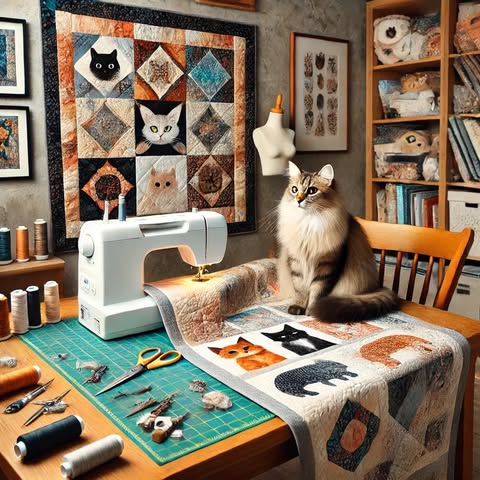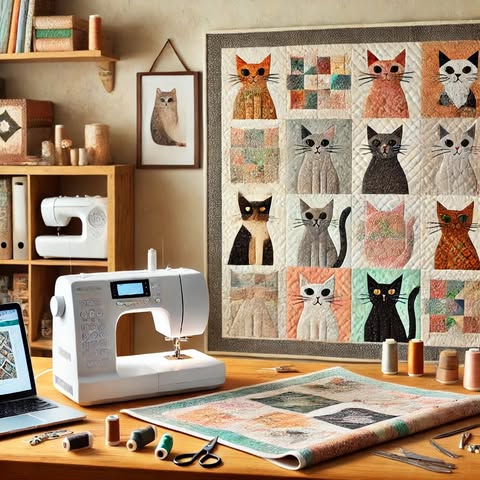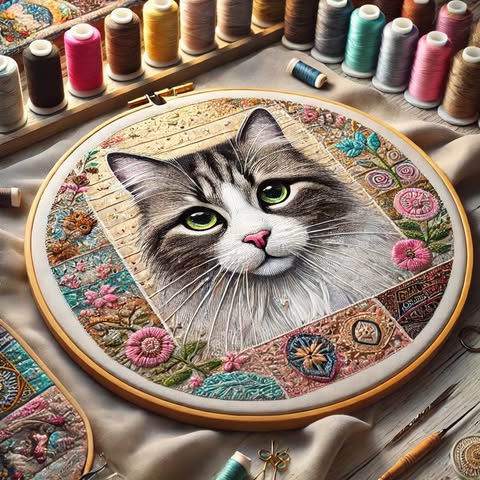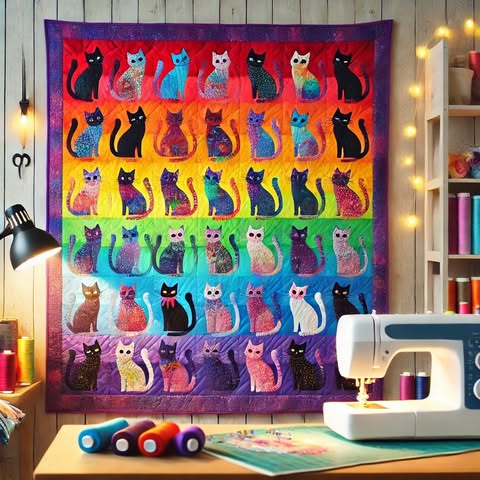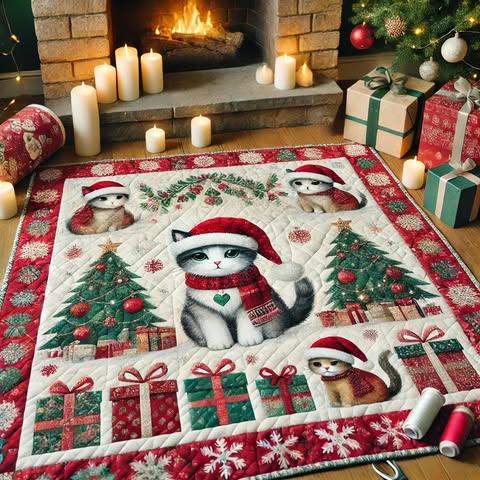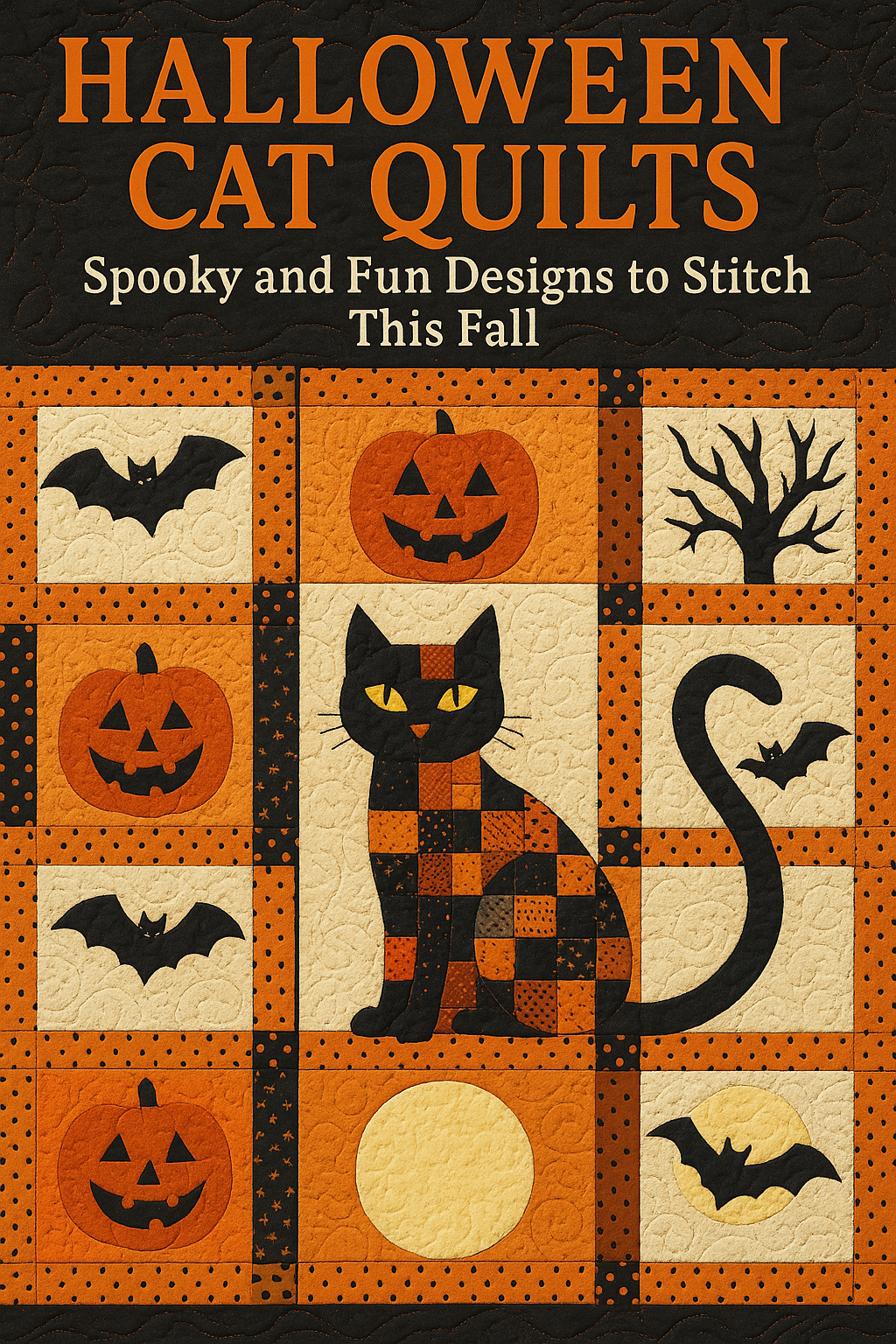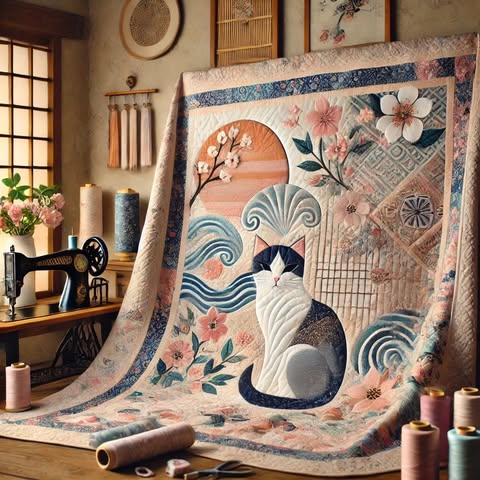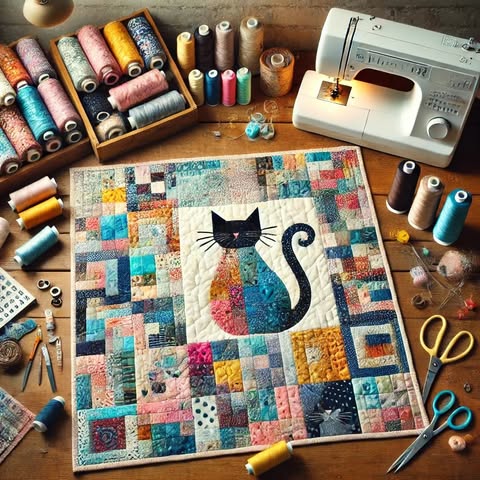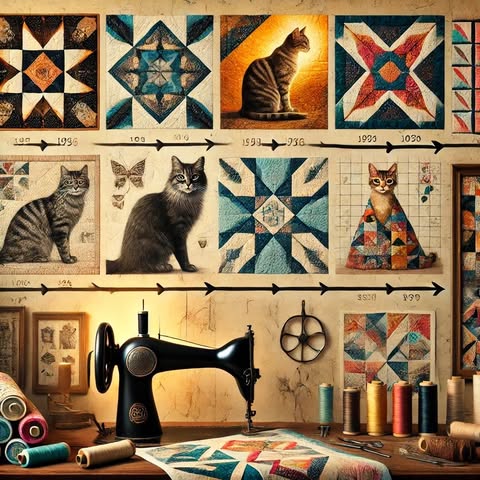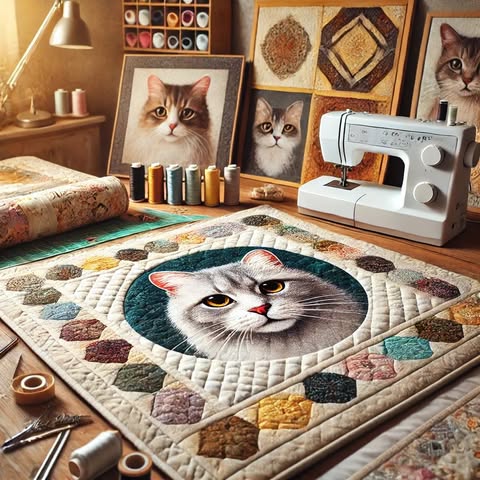Quilting for Cat Lovers: How to Make a Quilt That Reflects Your Passion for Felines
Cat-Themed Quilting
Why Combine Quilting and a Love for Cats?
Quilting is a timeless craft that allows individuals to express creativity while producing something functional. For cat lovers, incorporating feline themes into quilting projects can be a delightful way to showcase their passion. Cat-themed quilts can range from simple paw-print patterns to intricate appliqué designs featuring lifelike cats. The combination of quilting and cat imagery offers endless possibilities, making it an exciting endeavor for crafters of all skill levels.
Beyond personal enjoyment, cat-themed quilts make heartfelt gifts for fellow feline enthusiasts. Whether for a birthday, holiday, or just because, a handmade quilt featuring cats can convey thoughtfulness and care. Additionally, quilting can be a therapeutic activity, reducing stress while allowing cat lovers to immerse themselves in a hobby that celebrates their favorite animals.
Choosing the Right Materials for a Cat Quilt
Selecting the appropriate fabrics and supplies is crucial for creating a durable and visually appealing quilt. Cat-themed quilts often benefit from a mix of solid colors and printed fabrics featuring cats, paw prints, or playful motifs like yarn balls and fish. Cotton is the most popular choice for quilting due to its durability and ease of handling, but flannel can add a cozy touch, especially for lap quilts.
Thread selection is another important consideration. High-quality cotton or polyester thread ensures smooth stitching, while embroidery thread may be necessary for detailed cat designs. Batting, the middle layer of the quilt, determines its warmth and thickness. Polyester batting is lightweight and easy to work with, while wool provides superior insulation.
Planning the Design: From Simple to Complex
Before cutting any fabric, it’s essential to plan the quilt design. Beginners may opt for straightforward patterns like a patchwork quilt with alternating cat-printed and solid squares. More advanced quilters might explore intricate piecing techniques or appliqué to create realistic cat silhouettes.
One popular approach is the “cat in the window” design, where fabric panels mimic cats peering out of quilted frames. Another idea is a “whiskers and paws” theme, using curved piecing or embroidery to add delicate details. For those who enjoy storytelling through quilts, a narrative design—such as a quilt depicting cats in various playful poses—can be a charming choice.
Essential Tools for Cat-Themed Quilting
Having the right tools makes the quilting process smoother and more enjoyable. A rotary cutter, self-healing cutting mat, and clear quilting ruler ensure precise fabric cuts. Sharp fabric scissors are necessary for trimming threads and detailed appliqué work.
For piecing, a reliable sewing machine with a quarter-inch presser foot helps maintain consistent seam allowances. Hand quilters will need needles, thimbles, and quilting hoops to keep fabric taut while stitching. Additionally, marking tools like fabric chalk or washable pens assist in transferring designs onto fabric before sewing.
By gathering the right materials and planning the design carefully, cat lovers can embark on a quilting project that beautifully reflects their passion for felines.
Selecting Cat-Inspired Patterns and Colors
Popular Cat Quilt Patterns to Consider
Cat-themed quilts can feature a variety of patterns, from traditional block designs to modern artistic interpretations. One classic option is the “Cat’s Cradle” pattern, which uses geometric shapes to create an illusion of intertwined cats. Another beloved design is the “Flying Cats” variation of the “Flying Geese” pattern, where triangular pieces form the appearance of leaping felines.
For a whimsical touch, the “Crazy Cat Lady” quilt incorporates asymmetrical blocks with embroidered cat faces and playful motifs. Meanwhile, the “Cathedral Window” technique, though advanced, produces stunning three-dimensional effects that can mimic the graceful curves of a cat’s body.
Color Schemes That Complement Cat Themes
Choosing the right colors enhances the overall appeal of a cat quilt. Earthy tones like brown, beige, and gray mimic natural feline fur, while bold colors like teal, purple, or red create striking contrasts. Pastel shades work well for a softer, more whimsical look, especially in quilts intended for nurseries or children.
A monochromatic scheme—using varying shades of a single color—can lend elegance to the quilt. For example, a blue-toned quilt with dark navy cats on a light blue background creates a cohesive and sophisticated design. Alternatively, a rainbow-colored quilt with multicolored cats can evoke a playful, vibrant energy.
Incorporating Cat Silhouettes and Appliqué
Appliqué is a fantastic technique for adding detailed cat shapes to a quilt. Felt or fabric cutouts of cats can be stitched onto quilt blocks, creating a dynamic layered effect. Silhouette appliqué, where solid-colored cat shapes are sewn onto contrasting backgrounds, offers a bold and modern aesthetic.
For a more realistic approach, raw-edge appliqué allows quilters to attach fabric cats with minimal stitching, giving a slightly frayed, textured look. Needle-turn appliqué, though time-consuming, produces smooth, polished edges ideal for intricate designs like sleeping cats or playful kittens.
Using Embroidery to Enhance Feline Details
Embroidery adds depth and personality to cat quilts. Simple stitches like backstitch or satin stitch can outline cat faces, while French knots create tiny eyes or nose details. More elaborate embroidery, such as thread painting, can replicate fur texture, making the cats appear lifelike.
Quilters may also incorporate humorous or sentimental phrases, such as “Purr Forever” or “Nine Lives Club,” using embroidered lettering. Combining embroidery with pieced or appliquéd cats results in a richly detailed quilt that truly celebrates a love for felines.
By carefully selecting patterns, colors, and embellishments, cat lovers can create quilts that are not only visually stunning but also deeply personal.
Piecing and Assembling Your Cat Quilt
Preparing and Cutting Fabric for Quilt Blocks
Before sewing begins, fabric must be washed, dried, and pressed to prevent shrinkage and color bleeding later. Once prepped, precise cutting ensures uniformity in quilt blocks. Using a rotary cutter, quilting ruler, and self-healing mat, quilters should measure and cut fabric according to their chosen pattern.
For cat-themed quilts, some blocks may feature printed feline motifs, while others rely on solid colors for contrast. Careful organization of cut pieces—sorted by block design or color—helps streamline the assembly process. Mistakes in cutting can lead to mismatched seams, so double-checking measurements before making cuts is essential.
Sewing Techniques for Cat-Themed Blocks
Accurate seam allowances (typically ¼ inch) maintain consistency across quilt blocks. Chain piecing—a method where multiple pieces are sewn continuously without cutting threads—speeds up the process for repetitive blocks. Pressing seams open or to one side with an iron reduces bulk and ensures flat, professional-looking blocks.
For quilts featuring cat faces or silhouettes, foundation paper piecing (FPP) may be useful. This technique involves sewing fabric onto a printed paper template, allowing for precise angles and intricate details. Though FPP requires patience, it produces sharp, well-defined shapes perfect for feline designs.
Layering the Quilt Top, Batting, and Backing
Once all blocks are sewn together into a completed quilt top, the next step is layering. A flat, clean surface is necessary to prevent wrinkles or misalignment. The quilt backing (a single large fabric piece) is laid down first, followed by batting, and finally the quilt top.
Spray basting or safety pins temporarily hold the layers together before quilting. Smoothing out any bubbles or creases ensures an even finish. For cat quilts with detailed designs, basting every few inches prevents shifting during stitching.
Choosing Quilting Styles to Complement Cat Motifs
The quilting stitches not only secure the layers but also enhance the design. For beginners, straight-line quilting (using a walking foot) is a simple yet effective choice. Diagonal grid lines or gentle curves can mimic a cat’s playful movements.
Free-motion quilting (FMQ) allows for more creativity, such as stitching paw prints, whiskers, or even tiny mice around the cats. Those hand-quilting may opt for traditional patterns like clamshells or echo quilting around appliquéd cats for a textured effect.
By carefully piecing and assembling the quilt, cat lovers can ensure their project is both structurally sound and visually captivating.
Finishing Touches and Displaying Your Cat Quilt
Binding Techniques for a Polished Edge
Binding secures the quilt’s raw edges while adding a decorative frame. Double-fold bias binding is durable and flexible, especially for curved edges. After trimming excess batting and backing, binding strips are sewn to the front, then folded over and hand-stitched to the back for a clean finish.
For cat-themed quilts, binding can match the dominant color in the quilt or introduce a playful contrast—think bold red for a pop of color or soft gray to complement feline motifs. Mitered corners give a professional look, requiring careful folding and stitching at each turn.
Adding Personalized Embellishments
Extra details make a cat quilt truly unique. Buttons can serve as eyes for appliquéd cats, while embroidered whiskers add realism. Fabric paint or markers allow for small touches, like naming a quilted cat after a real-life pet.
Pom-poms, ribbons, or even small bells sewn into corners create interactive elements, perfect for quilts meant for children. However, embellishments should be securely attached to withstand washing and use.
Caring for Your Finished Cat Quilt
Proper maintenance preserves the quilt’s beauty. Machine washing on a gentle cycle with mild detergent is usually safe, but delicate quilts may require hand-washing. Air-drying flat prevents stretching, though a low-heat tumble dry can be used if necessary.
Storing the quilt in a cool, dry place—away from direct sunlight—prevents fading and fabric deterioration. For long-term storage, rolling instead of folding avoids permanent creases.
Creative Ways to Display and Enjoy Your Quilt
Beyond bedding, cat quilts can be hung as wall art using a sleeve sewn into the back. Draped over a rocking chair or folded at the foot of a bed, they add cozy charm to any room. Smaller quilts make delightful pet blankets, allowing real cats to lounge on fabric celebrating their kind.
Gifting a cat quilt to a fellow feline enthusiast is a heartfelt gesture. Pairing it with a handwritten note explaining the design choices adds a personal touch.
Celebrating Feline Love Through Quilting
Creating a cat-themed quilt is a rewarding way to merge craftsmanship with passion. From selecting fabrics to stitching the final binding, each step offers opportunities for creativity. Whether keeping the quilt as a personal treasure or gifting it to another cat lover, the finished piece is a testament to dedication and affection for felines.
By following these steps, quilters of all levels can produce a beautiful, functional work of art that celebrates their love for cats. The process may require patience, but the result—a one-of-a-kind quilt full of purr-sonality—is well worth the effort.
